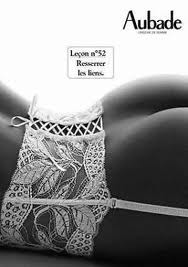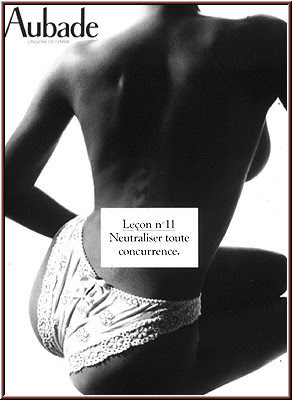Dear fellow Panties lover,
If like most women, you love the brand Aubade for all the lessons the brand taught you over the past 20 years, let’s discover more about this genius advertising strategy. (from Strategies.fr, article published in Strategies publication n°1253, October 2002.)
The lingerie brand Aubade owes its recognition to 10 years of artistic and sexy photos, which anyone would take great pleasure to collect.
Antoine de Caunes, a famous French actor recalls and tells the story of how he had two scooter accidents in his life: one while listening to a sketch on the radio; the second when running into an Aubade advertisement at a street corner. The now famous “Leçons de seduction” of Aubade are indeed very disturbing for our male counterparts. Close-up shots in Black&White, showing perfect breasts and backs, nice corsetry and some pieces of funny and quirky advice. “ Get him by his feelings”, “ Neutralize all competition”, “Set up the trick, and wait”, … the longevity of the campaign doesn’t go unnoticed. The first “lesson” is from 1992.
The campaign has been since then published in more than a hundred visuals in press and on billboards.
Black & White to be more daring
Ann-Charlotte Pasquier, CEO of Aubade, recalls the very beginning of the lessons: “We were aware of the fact that women had changed, she says. She loved seducing because she felt beautiful. She wasn’t a simple object anymore in men’s eyes.” In charge of the brand image, Ann-Charlotte Pasquier wants to take over the advertising campaign initiated by her father, Claude Pasquier who founded Aubade in 1958. Since the 70’s the photos are addressed to men. Seduction goes exclusively through their look. In 1974, Aubade promotes a bra that can be attached from the front, saving men from men’s nightmare”. In the 80’s, the visuals are signed “Aubade pour un home” which means in English “Aubade for a man”. It shows among other photos, a man, on his standing up, dominating, putting his hand on the shoulder of a women laying down.
Ann-Charlotte Pasquier recognizes the marketing skills of her dad “ He did put the light on the pleasure that can bring lingerie”. “Before that, a bra was something very functional” It was daring. The fist ad of the brand in 1968 was censored: it showed a couple, on a bed, in full daylight, with Aubade as a discreet accessory. They had to redo the ad before publishing it: they added a wedding ring to the hands of the couple and they closed the curtains. Black & White and shots without faces are already used. “In the 70’s, Aubade wanted to get out of the promotional use of these visuals only, and give a more artistic dimension to it. It is close to the luxury world. As for the Back & White, it allows us to be more daring.”
In order to show a woman with self confidence, and sure of her seduction power, Aubade’s CEO start looking for an agency. For 4 years they look without finding the right fit. Finally they ask Eric Flimon, who just started his own agency, Colette&Flimon. He created the concept of the “lessons”. “ When we presented the concept to the executive committee, my dad and I were the only two who wanted to adopt it.” she recalls.
Their tenacity ended up being worth it. They had bet on time to install the campaign. Two years later they were there. Their lesson number 5 “Feindre l’indifférence” (“Pretend to be indifferent” ) launched in 1993 finally gives some momentum to the brand, which records an increase of 35% of its turnover. The product presented, Tanga from the Bahia collection, has a huge success. It will become the reference of Aubade. But Colette & Flimon doesn’t survive to the new Sapin law in France. Ann-Charlotte Pasquier buys the rights for the lessons and gives it to Carlin International, which already manages the catalog and collections of the brand. Big names of the photography make their own “lesson” campaign, Hervé Bruhat, Hervé Lewis etc…
Why stop a winning business !
Selin K.
















